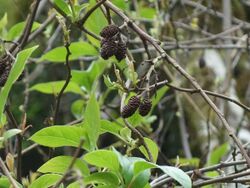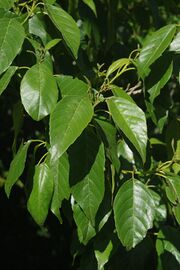Biology:Alnus formosana
| Formosan alder | |
|---|---|

| |
| Leaves and female infructescences | |
| Scientific classification | |
| Kingdom: | Plantae |
| Clade: | Tracheophytes |
| Clade: | Angiosperms |
| Clade: | Eudicots |
| Clade: | Rosids |
| Order: | Fagales |
| Family: | Betulaceae |
| Genus: | Alnus |
| Subgenus: | Alnus subg. Clethropsis |
| Species: | A. formosana
|
| Binomial name | |
| Alnus formosana (Burkill) Makino
| |
| Synonyms | |
| |
Alnus formosana, the Formosan alder, is a species of alder endemic to Taiwan.[1] It is a medium-sized tree, up to 20 metres (66 ft) in height[2] and 40 centimetres (16 in) in trunk diameter.[3]
Description
The formosan alder is a trees up to 20 meters in height with dark gray-brown bark. The petiole is 1.2-2.2 cm, slender; leaves elliptic or oblong-lanceolate, rarely ovate-oblong, 6-12 × 2–5 cm, hairy in the axils of lateral veins beneath, almost hairless above, rounded or broadly cuneate base, irregularly minutely serrated margin, acuminate or acute apex; lateral veins 6 or 7 on each side of the midrib. It has one female inflorescence, or 2-4 in a cluster, ellipsoid, 1-2.5 cm; peduncle 3–5 mm.[2]
Distribution and habitat
It is found in Taiwan. It is a common species growing on riverbanks from near sea level to 2,900 metres (9,500 ft).[2] It is commonly found in disturbed habitats as a pioneer species.[3]
Ecology
Alnus formosana flowers between May–June, fruiting between July–September.[2]
Uses
This tree is used for soil improvement.[3] It also finds use in gardens and as a windbreak. The tree trunks is also used in paper pulping and cultivating snow fungus and shiitake.[4]
The Atayal people uses A. formosana as a cover crop after clearing a new field, the traditional wisdom being that the soil becomes rich when it is cut cleared again in 10 to 15 years.[3][5] It is also used in the Pas-ta'ai ritual of the Saisiyat people.[6]
Early Han settlers of Taiwan name some places after the occurrence of the plant, the belief being that its occurrence is linked to ground collapse.[7]
References
- ↑ "Alnus formosana (Burkill) Makino". Royal Botanical Gardens Kew. https://powo.science.kew.org/taxon/urn:lsid:ipni.org:names:107662-1. Retrieved 5 January 2019.
- ↑ 2.0 2.1 2.2 2.3 Pei-chun Li & Alexei K. Skvortsov. "Alnus formosana". Flora of China. Missouri Botanical Garden, St. Louis, MO & Harvard University Herbaria, Cambridge, MA. http://www.efloras.org/florataxon.aspx?flora_id=2&taxon_id=200006125. Retrieved 10 September 2012.
- ↑ 3.0 3.1 3.2 3.3 臺灣樹木解說第參冊. 臺北市: 行政院農業委員會. 1999. pp. 20.
- ↑ "台灣赤楊". kplant.biodiv.tw. http://kplant.biodiv.tw/%E5%8F%B0%E7%81%A3%E8%B5%A4%E6%A5%8A/%E5%8F%B0%E7%81%A3%E8%B5%A4%E6%A5%8A.htm. Retrieved 2017-03-27.
- ↑ COA. "泰雅族傳統「農林混合作業」所蘊含的生態知識──論南澳鄉金洋村的赤楊木栽植(農委會)". www.coa.gov.tw. http://www.coa.gov.tw/ws.php?id=20153. Retrieved 2017-03-27.
- ↑ "矮靈祭". web.chu.edu.tw. http://web.chu.edu.tw/~yshou/work_page/festival_dwarf.htm. Retrieved 2017-03-27.
- ↑ "森態資料庫介紹 | 台灣山林悠遊網". recreation.forest.gov.tw. http://recreation.forest.gov.tw/lib/lib_3_4_1.aspx?bio_id=53. Retrieved 2017-03-27.
Wikidata ☰ Q3926595 entry
 |




